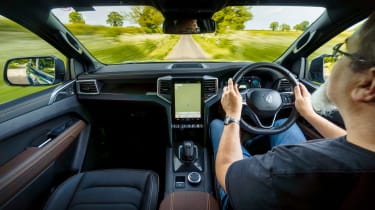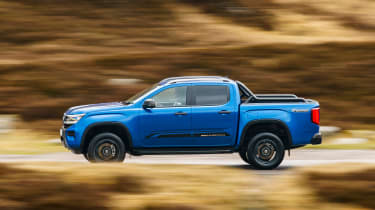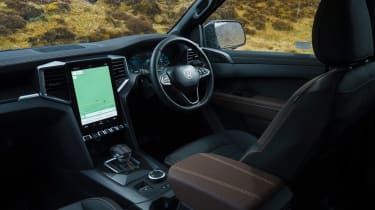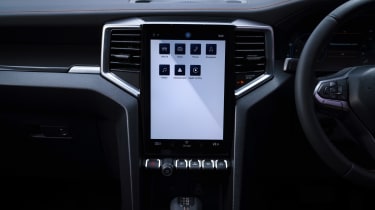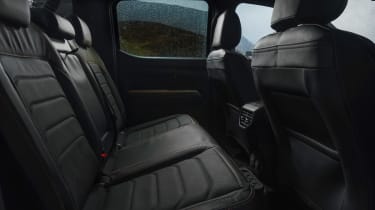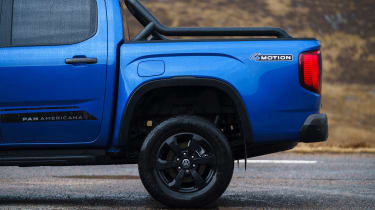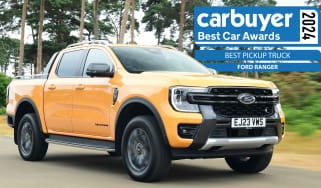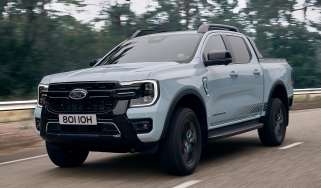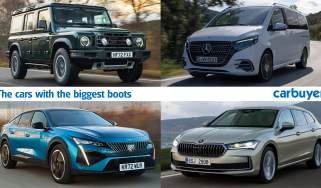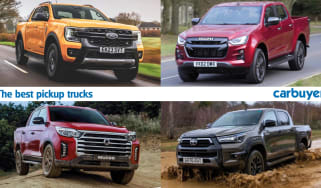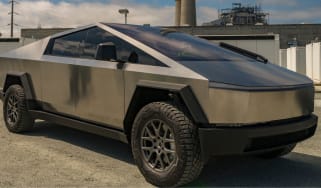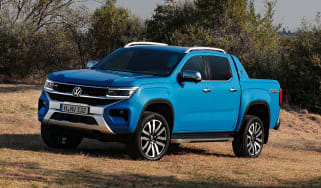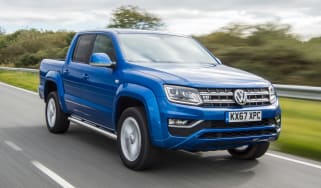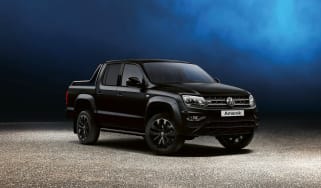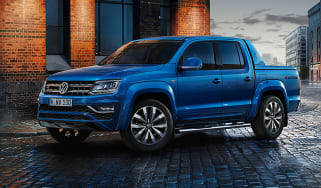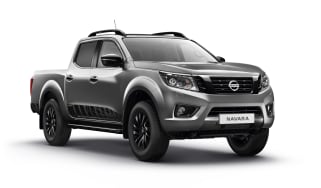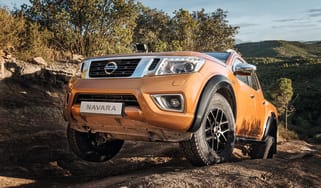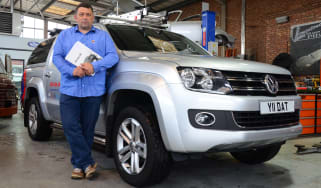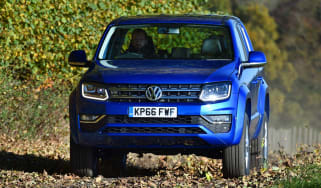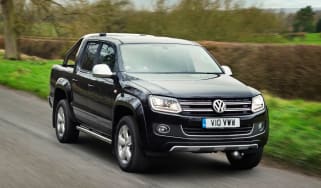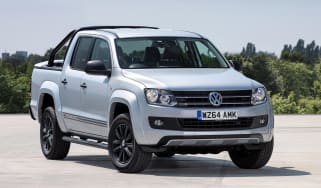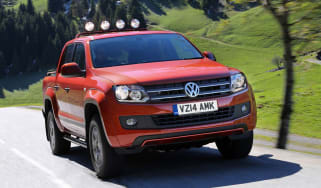Volkswagen Amarok pickup review
"The Volkswagen Amarok is an upmarket and capable pickup truck with the quality you’d expect from the VW badge"
Pros
- Luxurious interior
- Decent-sized loadbed
- Strong powertrains
Cons
- Only available as a Double Cab
- Automatic gearbox is sluggish
- Not that different from Ford Ranger
Verdict – is the Volkswagen Amarok a good pickup?
The Volkswagen Amarok is a decent pickup truck if you’re in the niche market for a capable utilitarian vehicle with plenty of premium features and feel. The cheaper, closely-related Ford Ranger will make more sense for buyers, especially since it’s offered in a wider variety of trims and options, but the Amarok does come with a longer five-year warranty. The Amarok PanAmericana trim has a high spec while still being classed as a commercial vehicle, so it costs less to tax benefit-in-kind, making it a desirable truck if you’re buying it through your business.
Volkswagen Amarok specs, models and alternatives
Since the original debuted in 2010, the Volkswagen Amarok has been a popular choice for those seeking something that’s a little bit more premium than the run-of-the-mill pickup truck offerings such as the Toyota Hilux, Isuzu D-Max and Carbuyer’s Best Pickup for 2023, the value-focused SsangYong Musso.
A new second-generation version of VW’s pickup made its debut in 2022 and shares the majority of its parts with the latest Ford Ranger. The refreshed truck is slightly wider than before in order to increase the load bed’s capacity and unlike the more commercially-focused Ford which is available in single cab, double cab and chassis cab forms, the lifestyle-oriented Amarok will only be offered as a double cab in the UK.
Under the bonnet, the new Amarok is powered by a range of four- and six-cylinder diesel engines, with all UK models coming as standard with 4MOTION four-wheel-drive. The lineup kicks off with the entry-level 168bhp 2.0-litre TDI – which is paired with a six-speed manual gearbox – and is topped by the 3.0-litre TDI which outputs 237bhp and a hefty 600Nm of torque, coming as standard with a 10-speed automatic transmission.
More reviews
In-depth reviews
From a glance at the spec sheet, it’s clear the Amarok is intended as a more upmarket alternative to the Ranger on which it’s based. As well as cloth upholstery, vinyl flooring, and 17-inch alloys, the entry-level Life models get an eight-inch digital dial setup, 10-inch infotainment screen with Apple CarPlay and Android Auto, as well as safety kit including front and rear parking sensors, a reversing camera, adaptive cruise control and road sign recognition. In fact, the Amarok achieved a five-star Euro NCAP score thanks to its generous suite of safety tech.
Top-spec Aventura models even bring luxuries such as leather upholstery, a heated steering wheel and chrome and silver trim, so the Amarok fills the luxury pickup niche quite comprehensively.
On paper, the Amarok looks like a tempting proposition; however, the Ford Ranger on which it's based does almost everything the Amarok can do for a cheaper price. It remains to be seen whether the Volkswagen badge can sway buyers away from the Ford, but regardless the new Amarok represents a great leap forward from the old model and is a solid choice for anyone looking for a work truck that can also function as a family runaround.
MPG, running costs & CO2
Despite Volkswagen claiming the Amarok has been designed ‘with electric power in mind’, none of the truck’s powertrains come with any form of hybrid or electrical assistance; therefore, the Amarok is much thirstier than a similarly-sized family SUV.
Volkswagen is yet to detail exact fuel economy figures for any of the Amarok’s powertrains, but the entry-level 168bhp 2.0-litre TDI with the simple six-speed manual gearbox is undoubtedly the most economical version of the Amarok to buy and run, with an official fuel economy figure of up to 33.6mpg. The more-powerful 201bhp 2.0-litre twin-turbocharged diesel with a 10-speed automatic gearbox should return only slightly lower figures. The thirstiest model in the range is undoubtedly the 3.0-litre V6 TDI, which does up to 28mpg, according to official figures.
All versions of VW’s pickup are classed as commercial vehicles, though, so can therefore be purchased for business use without paying VAT. Benefit-in-Kind tax bills should remain low, too.
Unlike most Volkswagens, the Amarok comes with a ‘5+ Promise’, consisting of a five-year 124,000-mile warranty, five services and five years of roadside assistance. VW claims this could save customers up to £2,300 and provides “total peace of mind”. It’s a welcome upgrade over its typical three-year warranty, which should help the Amarok compete with the likes of the SsangYong Musso which gets seven years of cover as standard, while the Toyota Hilux gets up to 10 years of warranty, thanks to the brand’s ‘Relax’ programme. It also gives the Amarok a selling point over the Ford Ranger, which only gets three years of standard cover.
Engines, drive & performance
Though a two-and-a-half tonne pickup truck may sound like a behemoth that’s too large for UK roads, it's worth remembering that many hybrid and electric SUVs weigh around the same, meaning the Amarok doesn’t feel as ungainly as you might expect.
When we drove the Amarok we found it felt almost as refined as a large, modern SUV. There’s little to no wind or road noise, even at motorway speeds. The suspension is slightly shaky – that’s to be expected from a pickup designed to carry heavy loads at the back – but overall it rides well and is impressively smooth most of the time. It’s surprisingly easy to manoeuvre for such a large vehicle, too, thanks to its light controls. The high driving position means you get a good view for the most part, despite the high bonnet line restricting it somewhat.
Most of the time, the truck resorts to rear-wheel-drive to save fuel, however there is an automatic 4WD mode that can send power to any of four wheels in order to maintain maximum grip. Despite its light steering, it's easy to understand where the Amarok is heading and while the suspension is disturbed by the largest of potholes, the VW is incredibly refined for a truck that’s supposed to support payloads in excess of 1,000kg.
At launch, buyers can choose from one of three diesel engines: two 2.0-litre four-cylinder units and a range-topping 3.0-litre six-cylinder TDI. The four-cylinder versions output 168bhp and 201bhp respectively and are likely to be the top sellers in the UK. While neither looks like it offers enough grunt for such a substantial vehicle, plenty of torque means both should offer satisfactory performance.
The top-of-the-range 3.0-litre TDI was fitted to our test car, and produces 237bhp and a muscular 600Nm of torque – in the PanAmericana this propels the Amarok from 0-62mph in nine seconds. For such a large car, acceleration felt very impressive, and for the most part the 10-speed automatic transmission is smooth and keeps the car in the correct power band – the only time it occasionally tripped up was under acceleration.
All versions of the Volkswagen Amarok come with the same 10-speed automatic transmission, bar those specced with the entry-level 2.0-litre 168bhp engine, which comes equipped with a six-speed manual. The automatic can be slow to respond at times, but generally remains smooth as it slushes through the gears.
Interior & comfort
Ford greatly impressed us with the latest Ranger’s interior and while it’s evident that the Amarok shares many of its parts with it, a handful of Volkswagen touches elevate the German truck even further above its American counterpart.
As you’d expect from a commercial vehicle, everything you touch feels solid and long-lasting, however the Amarok also boasts a handful of luxurious items that make the cabin almost feel like that of an SUV passenger car. Top-spec pickups have interiors wrapped in leather, with it even extending onto the dashboard. Dual-zone climate control is another nice addition, while a row of knurled switches below the infotainment screen add a further touch of class.
Speaking of the infotainment screen, the 12-inch portrait-style unit (10.1 inches on entry-level trucks) has been pulled straight out of the Ranger, albeit with Volkswagen adding its own graphics and software. This is much better to use than VW’s own laggy infotainment setups and is paired with a 12.3-inch digital instrument cluster (measuring eight inches on lower-spec models) mounted behind the steering wheel. Drivers can configure this screen to show several bits of important information, with the overall look of the dials changing in respect to whatever drive mode you’re in.
Amarok buyers have a choice of four distinct trim levels: Life, Style, PanAmericana and Aventura. Entry-level Amarok Life models get a strong level of standard equipment for a commercial vehicle, including LED headlights, 17-inch alloy wheels, a leather-wrapped multifunction steering wheel, air con, power-folding heated mirrors, eight-way adjustable front seats, a 10-inch touchscreen, an eight-inch digital instrument cluster, a reversing camera and front and rear parking sensors.
Step up to Style and you get matrix LED headlights, a 360-degree camera, autonomous parking assist tech, a 10-way adjustable driver’s seat, ambient interior lighting, 18-inch alloy wheels, chrome exterior elements, 12-inch digital gauge cluster, 12-inch infotainment screen with navigation, wireless phone charging and keyless start and go.
Top-of-the-line PanAmericana and Aventure models prioritise off-road capability and luxury respectively. Both get 10-way adjustment capability to the front passenger seat, a premium Harman Kardon sound system, LED cargo area lighting and a Comfort suspension system. Panamericana also gets a protective scrape plate underneath, a locking rear differential and off-roading tyres.
Aventura gets added luxury features such as the aforementioned premium sound system, leather seats, heated steering wheel, 21-inch alloy wheels, silver roof rails, chrome exterior touches, and more advanced Park Assist tech.
Practicality & boot space
The Volkswagen Amarok is only available in five-seat double cab form in the UK, which is good news if you’re looking to carry passengers, but may be disappointing for those looking for maximum carrying capacity.
Thanks to a longer wheelbase (the distance between the front and rear wheels) there’s more space inside the Amarok than ever before. Adults can sit in the rear without any issue and there’s even a fold-down centre armrest to help passengers get comfortable on longer journeys.
Things aren’t as bad as they seem bed-wise though, as the new Amarok is wider than the model it replaces, meaning there’s now space in the back to carry a full-size pallet. Volkswagen says the Amarok’s maximum payload is 1,160kg.
With plenty of torque available from its range of diesel engines, the Amarok should have no problem with towing. All models can haul a braked trailer weighing up to 3,500kg.
Reliability & safety
The Volkswagen Amarok is mechanically similar to the new Ford Ranger and while that will mean replacement parts should be cheap and easy to come by, it doesn’t set a brilliant precedent for the ownership experience as a whole.
Neither Volkswagen nor Ford did particularly well in our 2023 Driver Power customer satisfaction survey, with the brands placing 27th and 28th respectively out of 32 manufacturers. Both marques were scored poorly for reliability by owners, and 26% of Volkswagen owners reported a fault within the first year. The Ranger and Amarok should hopefully be built tougher than the brands’ non-commercial models.
Independent safety body Euro NCAP tested the new Volkswagen Amarok in late 2022, and a wide range of safety equipment resulted in the truck being awarded a five-star score. The Amarok can be specified with up to 25 different safety and driver assistance systems, including an automatic speed limiter, autonomous emergency braking, lane-keep assist and a 360-degree camera system.


